Souvenirs from the 1939
New York
World's Fair Highly Collectible
by
Bob Brooke
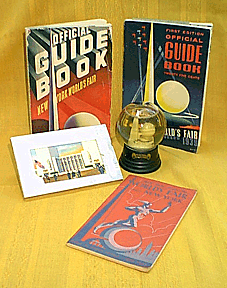 With
so many souvenirs from the 1939 New York World’s Fair out there, how
do collectors know what to look for? "You have to know what
attracts you to the Fair as a collector," said Judith Schwartz of
Twin Brooks Antiques of Bennington, Vt. "For me it was the Art Deco
logo of the Trylon and Perisphere, so I decided that the things I would
be acquiring would have to it on them." With
so many souvenirs from the 1939 New York World’s Fair out there, how
do collectors know what to look for? "You have to know what
attracts you to the Fair as a collector," said Judith Schwartz of
Twin Brooks Antiques of Bennington, Vt. "For me it was the Art Deco
logo of the Trylon and Perisphere, so I decided that the things I would
be acquiring would have to it on them."
For others, like Howard Rossen, author of the
book World’s Fair Collectibles with Price Guide, who began
collecting in 1965 when he was in law school, paper items, glass and
china, and key collectibles have been his passion. While Rossen collects
items from all the major world’s fairs, he enjoys collecting from the
1939 Fair the most.
Beginning collectors often purchase posters,
ticket books, and other assorted paper items, as well as any of the
hundreds of pinback buttons, mainly because of their relatively
inexpensive prices. Advanced collectors like clocks and watches--the
harder-to-find pieces. According to Schwartz, women often collect
jewelry--bracelets, rings, necklaces with Fair emblems.
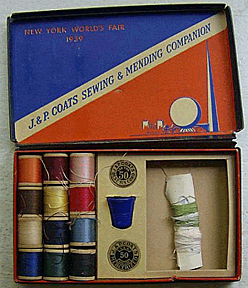 "Any
image of the Trylon and Perisphere on an item automatically makes it
more highly valued," added Schwartz. "But collectors seem to
be turning up their noses at the 1940 Fair items. This goes against what
collectors would normally do. Since Fair attendance was down in 1940 and
the Fair, itself, was surrounded by controversy, it seems logical that
there would be fewer items on the market, thus making these items more
valuable." "Any
image of the Trylon and Perisphere on an item automatically makes it
more highly valued," added Schwartz. "But collectors seem to
be turning up their noses at the 1940 Fair items. This goes against what
collectors would normally do. Since Fair attendance was down in 1940 and
the Fair, itself, was surrounded by controversy, it seems logical that
there would be fewer items on the market, thus making these items more
valuable."
Schwartz said that anything a little bit
different seems to be popular with collectors of World’s Fair
souvenirs today. "The ubiquitous milk glass vinegar bottle and
coins are passe now," she said, "but anything unique will sell
in a second." For instance, a snow dome paperweight with black snow
falling on a Trylon and Perisphere, or a plastic pencil sharpener, or a
plywood jigsaw puzzle in its original box. They even sold birthday
candles in the shape of the Trylon and Perisphere.
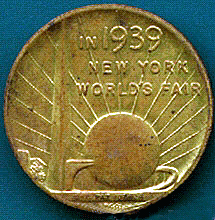 Most major manufacturers of fine china,
novelties and toys made items for the Fair. The Arcade Toy Company made
a four-piece metal tram with driver painted in bright orange and blue
Fair-Corporation approved colors. RCA Victor created a splendid table
model radio. Macy’s had a Most major manufacturers of fine china,
novelties and toys made items for the Fair. The Arcade Toy Company made
a four-piece metal tram with driver painted in bright orange and blue
Fair-Corporation approved colors. RCA Victor created a splendid table
model radio. Macy’s had a
Toyland Dutch girl doll made for them by the
Alexander Doll Company. An assortment of ladies’ cosmetic
compacts--from Girey, Elgin-American and Zekll--proliferated at the
Fair. Even Parker Brothers got in on the act with a board game called
Bobby and Betty’s Trip to the New York World’s Fair. And Whitman
Publishing Company created New York World’s Fair Bingo.
Most Sought After Items
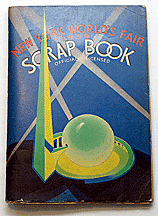 But
some of the items most sought after by collectors are a series of china
plates attributed to Homer Laughlin, creator of Fiesta Ware. These
attractive plates in purple and green sported stylized buildings around
their rims and Deco logos. Also highly prized is a series of plates from
the joint exhibit of management and labor. These pottery plates were
made at the Fair, although everyone seems to think they were made by
Homer Laughlin because they have the Fiesta Ware look. Some of the most
beautiful ones were made by Cronin China Company, J&G Meakin, and
Mason’s China Company of Great Britain. The latter created a stunning
scalloped souvenir plate showing New York skyline. But
some of the items most sought after by collectors are a series of china
plates attributed to Homer Laughlin, creator of Fiesta Ware. These
attractive plates in purple and green sported stylized buildings around
their rims and Deco logos. Also highly prized is a series of plates from
the joint exhibit of management and labor. These pottery plates were
made at the Fair, although everyone seems to think they were made by
Homer Laughlin because they have the Fiesta Ware look. Some of the most
beautiful ones were made by Cronin China Company, J&G Meakin, and
Mason’s China Company of Great Britain. The latter created a stunning
scalloped souvenir plate showing New York skyline.
Art Deco china display plates were also
manufactured by the Edwin Knowles China Co. Even Tiffany and Company got
in on the act with a pink and white china place setting featuring
pictures of modern New York. There were also china pieces from Scammell’s
Lamberton China Company(George Washington commemorative plates), Atlas
China(scalloped plate), Paden City Pottery Co(salad bowl), Hall
China(cobalt blue teapot), and Porcelier China(cream colored teapots and
pitchers), plus hundreds of items made in Japan, including assorted
lusterware, hand-painted porcelain, jasperware and imitation Wedgewood.
The Libby Glass Co. made sets of eight juice glasses in a holder.
Fakes Galore
The market has spawned fakes, actually fantasies--items made to look
like they were produced for the Fair but are actually new. Schwartz
warns collectors about rings and cuff links that are surfacing, as well
as paper coasters in the shape of the Trylon and Perisphere that sport a
Coca Cola emblem. All are obviously in mint condition.
Rossen said that police badges have also been
reproduced and again, some as fantasy pieces, since these are also
popular with those who collect police memorabilia. "However, I’ve
seen very few reproductions from any World’s Fair," he said.
 As
for the market, both Schwartz and Rossen agree it’s sky high. "I
assume it will level off somewhere," said Schwartz. "I bought
four little cups for $185 that I thought were drinking cups, but it
turned out that they were toothpick holders and sold them for $400. I
find out later that I could have sold them for probably $400 a
piece!" As
for the market, both Schwartz and Rossen agree it’s sky high. "I
assume it will level off somewhere," said Schwartz. "I bought
four little cups for $185 that I thought were drinking cups, but it
turned out that they were toothpick holders and sold them for $400. I
find out later that I could have sold them for probably $400 a
piece!"
Each year on Memorial Day Weekend, the World’s
Fair Collector’s Society sponsors a show of only 1939 World’s Fair
collectibles at the Andria Motel on Northern Boulevard just opposite
Corona Park. "At this year’s show I saw only three or four rare
pieces," said Rossen.
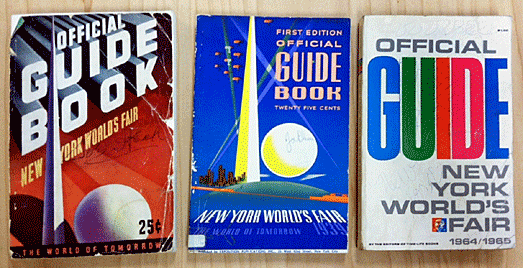
"Most of the rest was middle of the road
stuff. But everything from that fair is getting much more collectible
because ‘39 and ‘40 are so hot and there are so many new collectors
coming in."
"It’s all supply and demand," he
added. "The really good stuff is unavailable. In fact, I recently
bought a duplicate piece for $700--a Remington typewriter in mint
condition--and made a major investment. It’s only the fourth
typewriter I’ve seen in 25 years!"
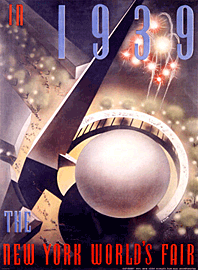 Prices for paper goods can be as low as $5 for
a postcard but can climb to $275 for a girl guide’s jacket and upwards
of a $1,000 for a set of New York World’s Fair silver flatware by
William Rogers Co. and over $2,000 for an RCA table model radio. Prices for paper goods can be as low as $5 for
a postcard but can climb to $275 for a girl guide’s jacket and upwards
of a $1,000 for a set of New York World’s Fair silver flatware by
William Rogers Co. and over $2,000 for an RCA table model radio.
Schwartz’ advice for 1939 World’s Fair
collectors: Start small and inexpensive. "Get an education while
you’re learning and don’t exhaust your resources right away, "
she said. "If you’re going to make a mistake, make one at the $5
or $10 level not at the $600 level."
The World’s Fair Corporation buried a time
capsule under the Westinghouse Building so that future generations in
the year 6939 would be able to get an idea of what life was like in
1939. Torpedo shaped and 7 ½ feet long and 8 ½ inches in diameter, it
contained samples of plastics, metal and fabrics, numerous books and
essays reproduced on microfilm, newsreels with instructions and a key to
the English language. What they forgot to include was an assortment of
souvenirs of the Fair, which while clear to fair goers at the time,
would probably confuse generations to come.
To read more articles by Bob Brooke, please visit
his Web site
<
Back to Collectibles Archives
Next Article > |
